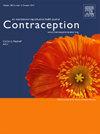DOES PSYCHOSOCIAL BURDEN DIFFER WHEN ACCESSING MEDICATION ABORTION USING NO-TEST, TELEHEALTH CARE COMPARED TO IN-PERSON CARE WITH ULTRASOUND?
IF 2.8
2区 医学
Q1 OBSTETRICS & GYNECOLOGY
引用次数: 0
Abstract
Objectives
We aimed to explore whether no-test, telehealth abortion care reduces the psychosocial burden of abortion care-seeking.
Methods
As part of a study on the safety and effectiveness of telehealth abortion care, from May 2021-March 2023, we surveyed and abstracted medical record data for 583 patients obtaining medication abortion ≤ 70 days gestation, English- or Spanish-speaking, ages ≥ 15 years at four abortion clinic organizations in six US states. We assessed three psychosocial burden dimensions (structural challenges, five items, α=0.80; lack of autonomy, three items, α=0.73; and others’ reactions to the pregnancy, two items, α=0.88, range 0–3) by study group (1) telehealth and mailing medications, (2) no-test and pick-up medications, and (3) in-person with ultrasound.
Results
A total 403 enrolled participants completed psychosocial burden items. In adjusted analyses, telehealth by mail was associated with fewer structural challenges than in-person care (-0.12, 95% CI -0.23,-0.00), mostly due to less difficulty traveling for care (24% vs 32%, p<0.05). While mean lack of autonomy scores did not differ by study group, the telehealth by mail (11%) and no-test and pick-up (12%) groups were less likely to feel forced to wait for the abortion after making the decision, when compared to the in-person with ultrasound group (22%, p<0.05). The no-test and pick-up group (35%) was also less likely to be worried about friends/family members’ reaction to the pregnancy than the in-person care group (42%, p<0.05).
Conclusions
No-test, telehealth medication abortion care may reduce the psychosocial burden of abortion-seeking, in particular the burden of travel and feeling forced to wait for care.
与使用超声波的面对面护理相比,使用免测试远程保健进行药物流产时的社会心理负担是否有所不同?
作为远程医疗流产护理安全性和有效性研究的一部分,我们在 2021 年 5 月至 2023 年 3 月期间调查并摘录了美国 6 个州 4 家流产诊所机构中 583 名妊娠期≤70 天、讲英语或西班牙语、年龄≥15 岁的药物流产患者的病历数据。我们评估了三个社会心理负担维度(结构性挑战,5 个项目,α=0.80;缺乏自主权,3 个项目,α=0.73;他人对妊娠的反应,2 个项目,α=0.88,范围 0-3),按研究组(1)远程医疗和邮寄药物,(2)免检和取药,以及(3)当面超声检查。在调整后的分析中,邮寄远程医疗比面对面医疗面临更少的结构性挑战(-0.12,95% CI -0.23,-0.00),这主要是由于旅行就医的困难较少(24% vs 32%,p<0.05)。虽然缺乏自主权的平均得分在不同研究组之间没有差异,但邮寄远程保健组(11%)和免检取件组(12%)与超声波当面检查组(22%,p<0.05)相比,在做出决定后感到被迫等待流产的可能性较低。免检和取药组(35%)担心朋友/家人对怀孕的反应的可能性也低于亲自护理组(42%,p<0.05)。
本文章由计算机程序翻译,如有差异,请以英文原文为准。
求助全文
约1分钟内获得全文
求助全文
来源期刊

Contraception
医学-妇产科学
CiteScore
4.70
自引率
17.20%
发文量
211
审稿时长
69 days
期刊介绍:
Contraception has an open access mirror journal Contraception: X, sharing the same aims and scope, editorial team, submission system and rigorous peer review.
The journal Contraception wishes to advance reproductive health through the rapid publication of the best and most interesting new scholarship regarding contraception and related fields such as abortion. The journal welcomes manuscripts from investigators working in the laboratory, clinical and social sciences, as well as public health and health professions education.
 求助内容:
求助内容: 应助结果提醒方式:
应助结果提醒方式:


